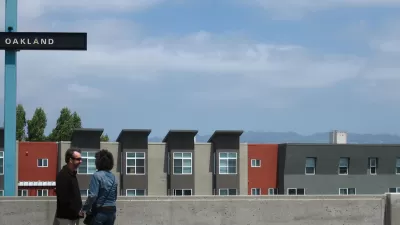The U.S. Supreme Court turned down a request by the National Association of Home Builders to hear their lawsuit against the San Joaquin Valley Air Pollution Control District's use of the 'indirect source rule', better known as a 'smog fee'.
The ruling by the court has tremendous implications for air districts as they view land uses as sources of air pollution. Sprawling, auto-dependent developments may be forced to pay "indirect source fees" to the regulators because of trips generated.
The Home Builders had already lost at the U.S. District and Appeals court levels.
"The news... hands a victory to air pollution regulators and environmental groups. It also means that Bay Area air regulators, who had been watching the case with interest, are likely to adopt a similar rule in the next few years.
"Developers have been able to largely avoid the same regulations that apply to a smokestack," said Paul Cort, an (Earthjustice) attorney who represented the Sierra Club and Environmental Defense Fund in the case. "But these projects do create pollution by adding to the vehicle miles traveled."
"The decisions (developers) make on where to build and how to build do make a difference," said Cort. "Smarter development means reduced air pollution. This creates an incentive to promote infill development, to build next to existing mass transit, and to build more pedestrian friendly projects."
Thanks to Gita Dev
FULL STORY: Environmental groups, state regulators win major smog case over home developers

Maui's Vacation Rental Debate Turns Ugly
Verbal attacks, misinformation campaigns and fistfights plague a high-stakes debate to convert thousands of vacation rentals into long-term housing.

Planetizen Federal Action Tracker
A weekly monitor of how Trump’s orders and actions are impacting planners and planning in America.

San Francisco Suspends Traffic Calming Amidst Record Deaths
Citing “a challenging fiscal landscape,” the city will cease the program on the heels of 42 traffic deaths, including 24 pedestrians.

Defunct Pittsburgh Power Plant to Become Residential Tower
A decommissioned steam heat plant will be redeveloped into almost 100 affordable housing units.

Trump Prompts Restructuring of Transportation Research Board in “Unprecedented Overreach”
The TRB has eliminated more than half of its committees including those focused on climate, equity, and cities.

Amtrak Rolls Out New Orleans to Alabama “Mardi Gras” Train
The new service will operate morning and evening departures between Mobile and New Orleans.
Urban Design for Planners 1: Software Tools
This six-course series explores essential urban design concepts using open source software and equips planners with the tools they need to participate fully in the urban design process.
Planning for Universal Design
Learn the tools for implementing Universal Design in planning regulations.
Heyer Gruel & Associates PA
JM Goldson LLC
Custer County Colorado
City of Camden Redevelopment Agency
City of Astoria
Transportation Research & Education Center (TREC) at Portland State University
Jefferson Parish Government
Camden Redevelopment Agency
City of Claremont





























